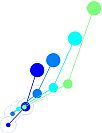The in vivo responses of dorsal raphe nucleus (DRN) serotonin neurons to emotionally-salient stimuli are a puzzle. Existing theories centred on reward, surprise, salience, and uncertainty individually account for some aspects of serotonergic activity but not others. Combining ideas from reinforcement learning (RL) theory with recent insights into the signal processing features of the DRN, here we find a unifying perspective in a prospective code for value. Such a code is both biologically realistic --- it arises from strong spike-frequency adaptation in serotonin neurons coupled with slow decoding via GPCRs --- and normatively justified --- it requires lower firing rates than broadcasting value directly, saving energy. Through simulations of trace conditioning experiments common in the serotonin literature, we show that our theory explains a wide range of experimental observations that previous theories have failed to reconcile, including phasic activation of serotonin neurons by both rewards and punishments, preference for surprising rewards but absence of a corresponding preference for punishments, and modulation of tonic firing by reward or punishment context. In head-to-head comparisons on previously-published in vivo data, our model better predicts serotonin neuron firing than previous models by a large margin. By reconciling previous theories and establishing a precise connection with RL, our work represents an important step towards understanding the role of serotonin in learning and behaviour.
- Poster

 PDF version
PDF version

